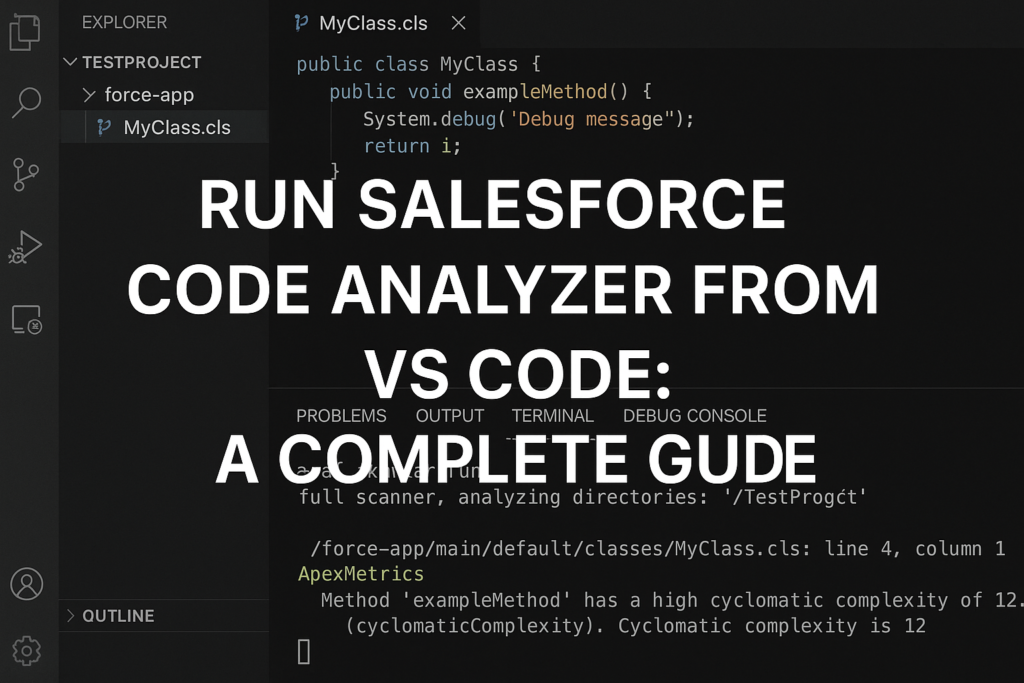Run Salesforce Code Analyzer from VS Code: A Complete Guide
Salesforce development is rapidly evolving, and maintaining high-quality, optimized code is essential for delivering robust applications. One of the best ways to ensure code quality is by using Salesforce Code Analyzer, which helps detect issues, enforce best practices, and improve maintainability. In this blog, we’ll walk you through running Salesforce Code Analyzer directly from Visual Studio Code (VS Code), a popular IDE for Salesforce developers.
What is Salesforce Code Analyzer?
Salesforce Code Analyzer is a tool that helps developers identify security vulnerabilities, code inefficiencies, and maintainability issues in Apex code. It’s built to work seamlessly with Salesforce DX (SFDX) and integrates directly into development workflows. By using it in VS Code, you can:
-
Detect potential bugs early
-
Enforce Salesforce coding best practices
-
Improve code performance and security
-
Maintain clean and organized Apex classes and triggers
Prerequisites
Before running Salesforce Code Analyzer, ensure you have the following setup:
-
Salesforce CLI (SFDX) installed
Download and install the Salesforce CLI from here. -
VS Code installed
You can download VS Code from here. -
Salesforce Extension Pack for VS Code
Install the Salesforce Extension Pack from the VS Code marketplace. It includes tools like Salesforce CLI Integration, Apex, and Visualforce support. -
Salesforce Project
You should have a Salesforce DX project or connected org in VS Code.
Step 1: Open Your Salesforce Project in VS Code
Open VS Code and navigate to your Salesforce project folder:
Make sure your project is recognized by VS Code as a Salesforce project (look for sfdx-project.json in the root directory).
Step 2: Authorize Your Org
Before running the analyzer, you need to connect your project to a Salesforce org:
-
-a MyOrgAliasassigns an alias for easier reference. -
Log in through the browser when prompted.
Step 3: Install Salesforce Code Analyzer
If not already installed, you can install the Salesforce Code Analyzer (PMD) plugin. Salesforce uses PMD under the hood to detect issues in Apex, Lightning Web Components, and Visualforce code.
Install it via npm:
Or check if it’s already installed:
Step 4: Run Code Analyzer
You can run the code analyzer in VS Code in a few ways:
Using the Terminal
Open the VS Code terminal (Ctrl + ~) and run:
-
--targetpoints to the folder you want to scan. -
--formatcan bejson,html,csv, etc. -
--enginespecifies the language engine (apex,lwc,visualforce). -
--outputspecifies the folder to store results.
Using the VS Code Command Palette
-
Press
Ctrl+Shift+P(Windows) orCmd+Shift+P(Mac) to open the Command Palette. -
Type
SFDX: Run Code Scannerand select it. -
Choose your target folder (e.g.,
classes,triggers). -
Select the output format (
htmlorjson).
Step 5: Review Results
After running the analyzer:
-
JSON format results can be opened in VS Code to see all warnings and errors.
-
HTML format results can be opened in a browser for a more visual report.
Typical findings include:
-
Security issues: SOQL injection, CSRF vulnerabilities
-
Code smells: Large classes, unused variables, long methods
-
Best practices violations: Hardcoded IDs, DML inside loops, etc.
Step 6: Fix Issues and Re-run
-
Go through the reported issues in your Apex classes or LWC components.
-
Fix the problems based on Salesforce best practices.
-
Re-run the analyzer to ensure your code is clean and maintainable.
Tips for Using Salesforce Code Analyzer Efficiently
-
Integrate with CI/CD: Run the analyzer as part of your deployment pipeline using Jenkins or GitHub Actions.
-
Exclude Generated or Third-Party Code: Avoid scanning auto-generated files to reduce noise.
-
Customize Rules: You can configure PMD rules using
sfdx-scannerto match your org’s coding standards.
Conclusion
Running Salesforce Code Analyzer from VS Code is a powerful way to improve your Salesforce development workflow. It helps detect security vulnerabilities, code inefficiencies, and ensures best practices are followed. By integrating it into your development process, you can maintain cleaner, safer, and more maintainable Salesforce code.

